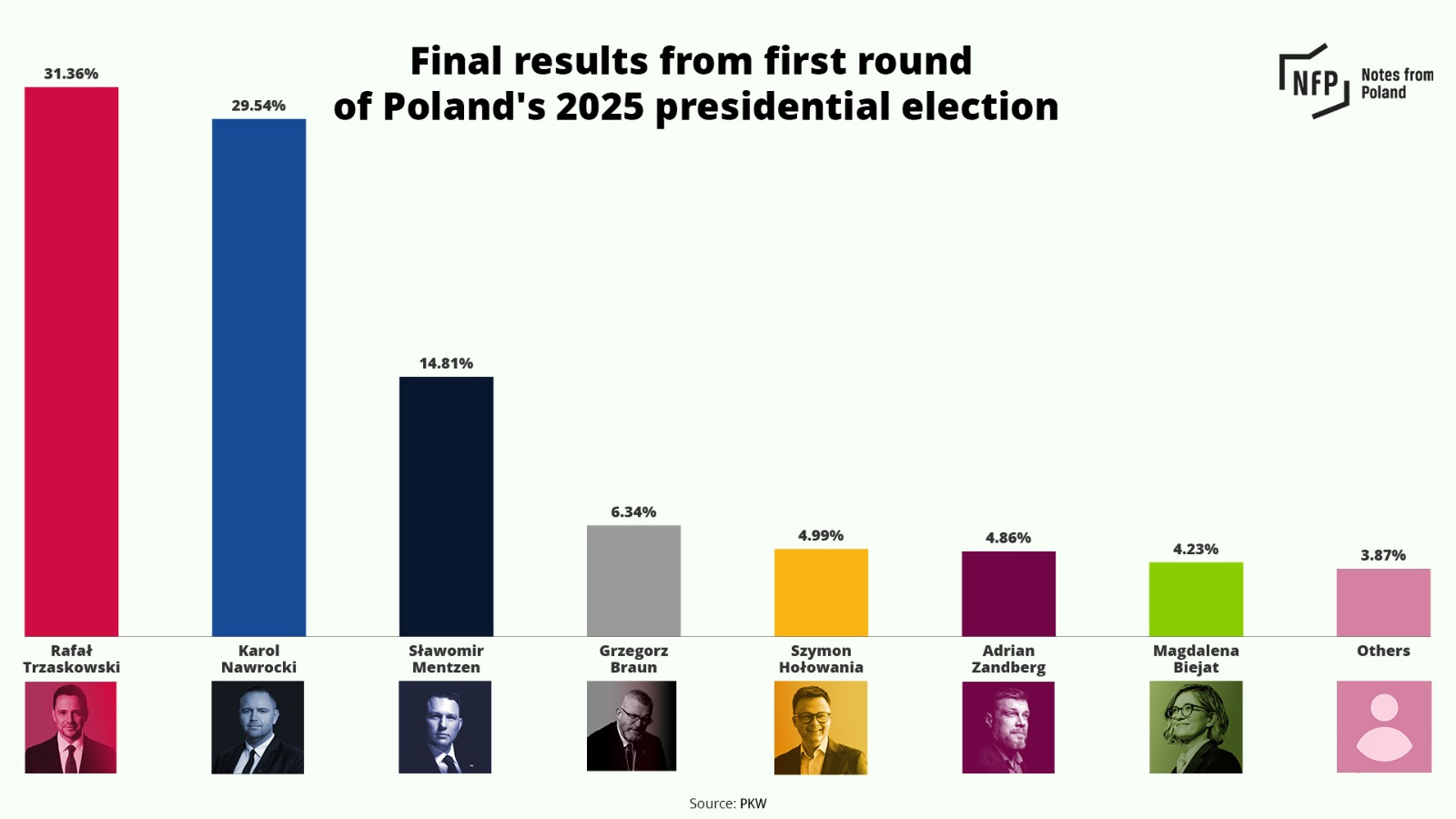Keep our news from advertisements and pay walls by making a donation to support our work!

Poland notes are managed by a small editorial team and are published by an independent non -profit foundation funded by donations from our readers. We cannot do what we do without your support.
The official results of the first series of the presidential election show a narrow victory for Rafał Trzaskowski (31.36%), the candidate of the Civic Platform Civic (PO), the Reduced Party of Poland, on Karol Nawrocki (29.54%), which is supported by the National Co-Conside (PIS).
They were followed by the extreme right figures of Sławomir Mentzen (14.81%) and Grzegorz Braun (6.34%) in third and fourth. Szymon Hołownia (4.99%), another centrist, was fifth, followed by candidates on the left Adrian Zandberg (4.86%) and Magdalena Biejat (4.23%).

Our editor -in -chief Daniel Tilles offers five conclusions of the results of the first round – and examines what they can mean for the decisive runoff of the second round on June 1 between Trzaskowski and Nawrocki.
Trzaskowski wins the battle but could lose the war
This is a strange thing to say about the person who won the first round, but Trzaskowski will be disappointed with the result.
His advance on Nawrocki is much narrower than the polls had predicted it. Even more problematic, the sharp increase in votes for the extreme right and disappointing results for other candidates of the ruling coalition, Hołownia and Biejat, makes much more difficult for him to trace a path to victory in the second round.
The results of the first round do not translate directly into what will happen in the second: some voters who presented themselves on Sunday can stay at home on June 1, and vice versa; It is difficult to predict how the support of certain candidates will separate in the second round.
Opposition presidential candidate @NAWROCKIKN has considerably reduced the difference in surveys to the choice of the ruling party @trzaskowski_ During the last month.@ Daniellles1 offers four theories about what was wrong for the frontrunner – and just for his challenger https://t.co/nrn3n1jvj
– Notes from Poland 🇵🇱 (@notesfropland) May 1, 2025
However, Trzaskowski now has the little enviable – and contradictory – objective of trying to gain a certain support from the left -wing voters and centrists who supported Zandberg, Biejat and Hołownia while trying to take at least a few votes from those who supported the chin from the main right.
Opinion polls and bookmakers are still making Trzaskowski the favorite to win the second round, but it will probably be an extremely close race.
Novice Nawrocki continues to take momentum
As I wrote at the beginning of this month, Nawrocki – a political novice that had never previously directed an elected office – became the campaign when he gained experience and recognition. This momentum has so far not been bumpy by the scandal that has emerged on a second apartment belonging to Nawrocki and the elderly disabled man who lives there.
However, as I also wrote, the apartments scandal was less likely to affect Nawrocki in the first round – when he could count on the basic voters of Pis – than in the second, when he needs to gain support from the outside of the party base.
Nevertheless, Nawrocki has reasons of optimism before June 1. He has a much clearer objective than Trzaskowski: winning the voters from other right -wing candidates and stimulating the participation of supporters of the Pis. This will simply mean continuing what he has already done during the campaign, in which Nawrocki presented himself as a hard and hard candidate on the right.
The main difficulty he will face is that, although Mentzen and his voters can be aligned with IP in their social conservatism, their economic libertarianism is completely in contradiction with the support of PIS for generous social protection and an important role for the State in the economy.
During the 2020 elections, those who voted for the Confederation candidate, Krzysztof Bosak, in the first round divided almost 50 to 50 between the Duda and Trzaskowski supported by Pis. Nawrocki will have to make sure it does much better than this time.
At the far right at high
Mentzen and Braun, who have taken more than 21% of the votes, have shown that the far right is a powerful political force in Poland. It was a significant improvement in their result in the last presidential election, when Bosak won just under 7%.
The result obtained this time by Braun – which led an openly anti -Semitic campaign, as well as anti -Ukrainian and anti -LGBT – is particularly striking.
Although Mentzen has always obtained a strong functionality in the polls, Braun was initially considered a marginal candidate, questioning between 1 and 2% for a large part of the campaign. However, a series of waterfalls in recent weeks before the vote, as well as the prominence which has been granted to it by televised debates, propelled it to a strong result.
A Polish presidential candidate asked prosecutors to bring charges against one of his rivals for his anti -Semitic remarks during a televised debate.
He declared the opposition to the “Judation” of Poland, saying that “the Jews have too many say in Polish affairs” https://t.co/gyqyal9cte
– Notes from Poland 🇵🇱 (@notesfropland) April 29, 2025
However, there are still large question points on the future of the extreme right. First of all, he faces the perennial question in the way of reaching power: only, it is almost certain to never reach a majority; But if he lined with worse or po, the two main parts, it would completely undermine his anti-establishment message.
Second, there are clear tensions in the far right: Mentzen was supposed to be their only candidate, but was then challenged by Braun, who was expelled from the Confederation.
However, this split can even be favorable to the Confederation, whose attempts to settle as a serious political party have benefited from the elimination of the extremely radical and controversial Braun, but which also retains the possibility of working with it and its faction in the future.
A divided left
According to standards in recent years, when it has often been in the political desert, the left as a whole has put a solid performance in this election. Between them, Zandberg and Biejat took more than 9% of the votes (which represents more than 10% during the inclusion of 1.1% of the votes won by the veteran Joanna Senyszyn).
It was much better than the results of the left -wing candidates in the last two presidential elections: 2.2% for Robert Biedroń in 2020 and 2.4% for Magdalena Ogórek in 2015.
However, the fact that the left votes this time were divided quite evenly between two candidates show the problem that the left has with Unity. Zandberg represents the “purist” wing, which represents shameless opinions on the left, whatever the circumstances or political consequences. Biejat comes from the “realistic” camp which thinks that it is preferable to compromise and work with centrist parties in order to achieve at least some of their objectives rather than any at all.
A small part on the left, together (Razem), decided to store the links with the coalition in power and to form a distinct parliamentary group.
He accuses the government of not having held its promises and says that it will vote against the state budget proposed in 2025 https://t.co/aia1qyerqs
– Notes from Poland 🇵🇱 (@notesfropland) October 28, 2024
Any fact that the two candidates finished this election with less than 5% of the votes: if their parties, together (Razem) and the left (Lewica), obtained such a result in parliamentary elections, they would both fall below the threshold to enter the Parliament. This is precisely what happened in 2015, leaving Parliament without any left -wing deputy.
Disappointment for Hołownia – and a warning to the power coalition
When Hołownia and its centrist Poland 2050 (Polska 2050) agreed to join the coalition government in 2023 – and itself took the leading role in Parliament – they hoped that it would be a springboard for its presidential ambitions.
In fact, it seems to have hurt it. While Hołownia obtained a solid result as a newcomer and independent in the 2020 presidential election, this time, as much as he tried to deny it, he stood clearly as an establishment figure, part of a government that opinion polls indicate is not largely popular.
Polls carried out to mark a year since @Donaldtusk Power Power shows that most poles have negatively evaluated the work of his government so far and much more think that their life has won that the best.
Women and young people are particularly disappointed https://t.co/qwzwvbyqbw
– Notes from Poland 🇵🇱 (@notesfropland) December 13, 2024
Its result and Biejat offer a warning to the camp in power, but also to a very small part which joins a coalition in power. Po and worse, which have dominated Polish politics for two decades, are used to swallowing smaller partners: see Modern (Nowoczesna) in the case of Po and Sovereign Poland (Swerenna Polska) in the case of Pis.
With just over two years before the next legislative elections, expect to see tastes of Poland 2050, from the left and the Polish people’s party (PSL), the last element of the camp in power, become more assertive when they seek to avoid political oblivion. This, in turn, will make it difficult for Prime Minister Donald Tusk de Po to collect his coalition on controversial issues.

The notes of Poland are managed by a small editorial team and published by an independent non -profit foundation funded by donations from our readers. We cannot do what we do without your support.
Main image credits: Zala / Wikimedia Commons, under CC by-SA 4.0; Czarnecki Radosław / Wikimedia Commons, under CC by-SA 4.0; Tomasz Molina / Wikimedia Commons, under CC by-SA 4.0; Czarneckiradek / Wikimedia Commons, under CC by-SA 4.0; Mikołaj Bujak / IPN (under CC by-NN 3.0 PL); Trzaskowsk.pl; Braun2025.pl; Klub Lewicy / Flickr (in the public field). Collage created by Agata Pyka

Daniel Tilles is editor -in -chief of Poland notes. He wrote on Polish affairs for a wide range of publications, especially Foreign policy,, Politico Europe,, EOobServer And Dziennik Gazeta Prawna.


